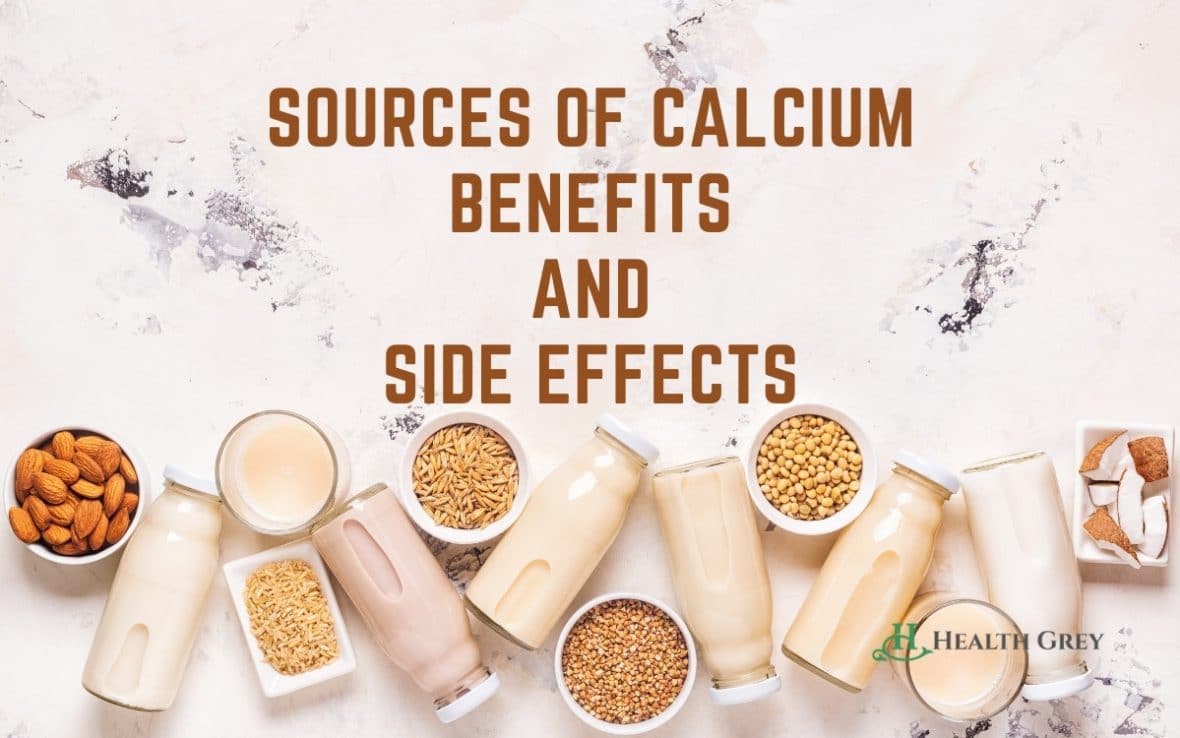All living things, including humans, require calcium as a nutrient. So here we are discussing calcium sources their benefits and their side effects. calcium functions as the most abundant mineral in the body and are necessary for bone health. Humans require calcium to build and maintain strong bones, and 99 percent of the calcium in the body is found in the bones and teeth. It’s also necessary for the brain and other parts of the body to function properly. It aids muscular activity as well as cardiovascular health.
Benefits:

Calcium has a variety of health benefits in the body. The following are some of them:
Bone health

The bones and teeth contain nearly all of the calcium in the human body. Calcium intake is necessary for bone synthesis, growth, and repair. Even after a person has stopped growing, calcium continues to help protect bones and reduce bone density loss, which is a typical part of the aging process.
Males and younger people lose bone density faster than women who have already gone through menopause. They have a higher risk of developing osteoporosis, and a doctor may recommend calcium supplements.
Muscle contraction

Calcium aids in the control of muscular contractions. The body produces calcium when a neuron activates a muscle. Calcium enhances muscle contraction by aiding muscle proteins. When the body pumps calcium out of the muscle, it relaxes.
Cardiovascular system

Calcium is essential for blood coagulation. Calcium plays several roles in muscle function. A reliable source maintains the cardiac muscle’s activity. Smooth muscles surrounding blood vessels relax when calcium is available. Several studies have suggested a relationship between calcium intake and heart disease.
Variety of calcium sources:
The world of calcium supplements is a vast one. From a dietary supplement derived from a part of a cattle’s bone to prescription medication, there are a wide variety of ways to get calcium into your body. Here are some foods that are the best sources of calcium.

- Yogurt is high in calcium, which is essential for the building and repair of bones, teeth, and nerve tissue. It is also easy to digest, which makes it an attractive food for people with healthy digestive systems.
- Milk: There are many different types of calcium available to us, including dairy products. In fact, The most abundant source of calcium in milk is consumed in the US, with over a billion people consuming cow’s milk daily. In addition, there are many different types of dairy that will provide you with calcium, but with different benefits and side effects.
- Non dairy calcium-rich foods for bones, such as soy milk.
- Sardines and salmon: Sardines are one of the quickest ways to get calcium into your diet, but since they are small, it may be difficult to eat the recommended amount. Canned salmon is also a good source of calcium, but because it is larger, you can eat more without worrying about it.
- Cheese is a calcium-rich food, but you know what’s even better? Cheese with added calcium. Go ahead, eat that extra-sharp cheddar, that extra-smelly blue, that extra-firm mozzarella. It’s filling, you’ll be glad you did.
- Tofu: While some people think that it is not a good source of calcium, it actually has more calcium than cow’s milk, canned tuna, and salmon. It’s a great source of phytoestrogens, a type of estrogen that can help balance your hormones and increase bone density.
- Leafy greens vegetables, such as broccoli, turnip leaves, watercress, and kale are plant-based sources of calcium
- Cereal: We all know that we should eat more calcium and less sugar and fat, and we all know the importance of getting the daily recommended amount of calcium. But, it’s harder than it sounds to find a good source of calcium in your cereal without it being too expensive. So, what are some ways you can get more out of your breakfast? Try some of these ideas.
- Fruit juices are nutritional powerhouses. They contain large amounts of nutrients in the little volume, which is great when you want to get in all the goodness in a hurry, but not great when you want to sip them slowly. For example, in one cup of orange juice, you get about one gram of calcium (2% of the recommended daily amount for men and women). One glass of milk (1 cup) delivers around 300 milligrams of calcium, about 10 times the amount found in an average one-cup serving of orange juice.
- Nuts and seeds, especially almonds, sesame seeds, chia seeds, and dried figs have been shown to have a wide range of health benefits, including lowering cholesterol and providing heart-healthy fats. In addition, they’re a fantastic source of many essential minerals, including calcium, magnesium, and iron. In fact, they’re so nutrient-dense that just a handful of nuts and seeds can provide you with all the essential vitamins and minerals you need for a day.
- Legumes and grains such as lentils, wheat, and white beans are rich in calcium. A study in the British Journal of Nutrition showed that legumes contributed to 74% of the calcium intake, the proportion of the most consumed foods to cover calcium deficiency.
- Cornmeal and corn tortillas are rich in calcium and low in sodium and cholesterol and may be a good source of calcium and magnesium and a good substitute for foods high in saturated fat.
- Sweet potatoes are rich in Calcium, about 50% of the daily requirement in a one-cup serving.
Side effects:

When calcium is taken by mouth in appropriate doses, it is LIKELY SAFE health for most people (about 1000-1200 mg daily). Calcium might produce modest side effects such as gas or belching. On the other hand, calcium is POSSIBLY SAFE when taken by mouth in levels more than the daily tolerated upper intake threshold (UL). For adults aged 19 to 50, the UL is 2000 mg, while for individuals aged 50 and more, the UL is 2000 mg.
Taking high calcium daily increases the risk of major side effects such as milk-alkali syndrome, which can lead to renal stones, kidney failure, and death. Supplemental calcium has also been linked to an increased risk of heart attack, but not all studies agree.
When calcium is taken by mouth in levels more than the daily tolerated upper intake level during pregnancy, it is possibly unsafe. The calcium intake UL is 3000 mg for those under the age of 18 and 2500 mg for those over 18. Higher calcium intake dosages may increase the infant’s risk of seizures. Take into account total calcium consumption from both dietary and calcium supplements sources.




